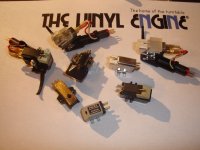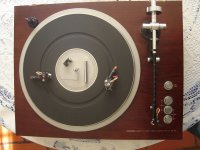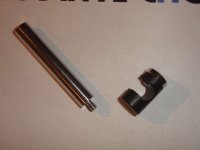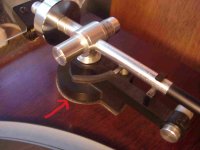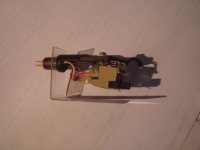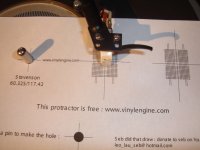Proof is in the pudding. History tells the tale, no? No proof as solid as the marketplace. Add to that the gentle slaps by the audio reviewers. 😎
Good? yes.
Great? well...you know. 😉
Good? yes.
Great? well...you know. 😉
For the most part sure. But air bearing arms are quite simple. Imo they are the best once you establish solutions to mass issues and add the appropriate cart.
I'm baffled by the apparent indifference to the effect of skating/AS from virtually all participants of this thread, though. It seems you are all(and I mean this respectfully)oblivious to the magnitude of it's influence. My experience has revealed it's every bit as sonically detectable as errant VTA. You hear the same magnitude of change as when VTA is being corrected on the fly. Both are phase driven issues. It makes perfect sense you would not be aware of this fact if you have not experienced it. Any dial type AS mechanism not integral to the moving arm wand is sufficient to observe this. This procedure also serves as an incidental sonic guage in determining how well best alignment of the cart has been achieved because the system will be so far off the range of adjustability if alignment is off that the AS mechanism will then be ineffective. Sonic disparity from skating occurs long before mistracking as can be confirmed with no AS operating. So there's more going on than meets the eye. There's a matter of cantilever suspension and it's own alignment as it pertains to the poles/armatures in the cart. So there's a large influence on phase distortion also from this, not just from the offset. Combine the two and you have a huge error to compensate for. It's the increased phase shift distortion due to tracking error that properly implemented AS corrects. In some cases providing a better stylus to groove interface than a correctly aligned cantilever to body relationship. This is because while listening on the fly, optimum condition can be with a slight cantilever/body offset due to the final correct(as can be) overall geometry.
This is why air bearing linear tracking arms are best.
Well maybe one other dual wand pivoted arm as well. 🙂
I'm baffled by the apparent indifference to the effect of skating/AS from virtually all participants of this thread, though. It seems you are all(and I mean this respectfully)oblivious to the magnitude of it's influence. My experience has revealed it's every bit as sonically detectable as errant VTA. You hear the same magnitude of change as when VTA is being corrected on the fly. Both are phase driven issues. It makes perfect sense you would not be aware of this fact if you have not experienced it. Any dial type AS mechanism not integral to the moving arm wand is sufficient to observe this. This procedure also serves as an incidental sonic guage in determining how well best alignment of the cart has been achieved because the system will be so far off the range of adjustability if alignment is off that the AS mechanism will then be ineffective. Sonic disparity from skating occurs long before mistracking as can be confirmed with no AS operating. So there's more going on than meets the eye. There's a matter of cantilever suspension and it's own alignment as it pertains to the poles/armatures in the cart. So there's a large influence on phase distortion also from this, not just from the offset. Combine the two and you have a huge error to compensate for. It's the increased phase shift distortion due to tracking error that properly implemented AS corrects. In some cases providing a better stylus to groove interface than a correctly aligned cantilever to body relationship. This is because while listening on the fly, optimum condition can be with a slight cantilever/body offset due to the final correct(as can be) overall geometry.
This is why air bearing linear tracking arms are best.
Well maybe one other dual wand pivoted arm as well. 🙂
And when you had to change the needle (which was unique for that TT), prepare yourself for a very large expense.
The incompatibility with other cartridges I think made them even more unpopular than their complexity.
It used a standard P Mount cartridge. Any mfr model would fit.
Terrible arm.
I am totally baffled by your statement!I'm baffled by the apparent indifference to the effect of skating/AS from virtually all participants of this thread, though.
Before you play with the VTA how do you verify the azimuth of the stylus in the groove? How do you verify the zenith of the stylus tip (perpendicularity to the longitudinal axis of the cartridge)? These are often out by several degrees in my experience, and these affect channel phase, channel balance and skating force generated more than the same degrees of misalignment VTA (which BTW is why the cutting standard for VTA is 20º±5º).
Records are not perfectly flat and the actual VTA of the cartridge relative to the record surface can vary more each revolution than the typical VTA adjustment range of a tonearm, although this is unusual. Linear tracking tonearms are typically worse in this regard because they are typically shorter than pivoting tonearms and that affects VTA variation up hill and down dale proportionally more.
I spend considerable time setting the tonearm / cartridge alignment on any high end turntable I service and that includes many with high end linear tracking tonearms. My penultimate test before a listening evaluation is the warped record test which qualifies cartridge/tonearm/turntable synergy, tracking, antiskating, distortion, tonearm resonance, cartridge output modulation and overall playback sound quality under perturbations laterally and vertically.
I have spent hours on VTA adjustments to satisfy clients' desire to explore possible changes in sound and let them judge, but I have rarely if ever delivered a turntable with a VTA other than that specified by the cartridge manufacturer. Clients who have previously used variable thickness mats to set VTA have reported to me that they don't need to bother after I have aligned their turntables.
Last edited:
It would behoove you to avail yourself the benefits of a record clamp.
There is also the issue of tolerances in the manufacturing process which actually renders their recommended specs to average values.
Hence my position that it should be done on the fly. Optimum sq rarely lands it at manufacturers' spec. However, the angle of the stylus will by virtue end up in the sweet spot relative to cutting angle. You simply won't get it there without listening for it just because of the variables. This is precisely why tonearms with adjustment on the fly exist. Azimuth on the fly would be nice. 🙂
There is also the issue of tolerances in the manufacturing process which actually renders their recommended specs to average values.
Hence my position that it should be done on the fly. Optimum sq rarely lands it at manufacturers' spec. However, the angle of the stylus will by virtue end up in the sweet spot relative to cutting angle. You simply won't get it there without listening for it just because of the variables. This is precisely why tonearms with adjustment on the fly exist. Azimuth on the fly would be nice. 🙂
I do have, use and recommend record clamps. All of the adjustments I do are dynamic and are typically verified by multiple methods and listening assessments.
To cover the actual range of cutting angles of records produced by different factories records the pivot hight of tonearm would need to be adjustable by a couple of centimetres and be able to be below the level of the platter in some cases.
To cover the actual range of cutting angles of records produced by different factories records the pivot hight of tonearm would need to be adjustable by a couple of centimetres and be able to be below the level of the platter in some cases.
Last edited:
Terrible arm.
The article talks about tangential arms in general,
which one do you mean?
It used a standard P Mount cartridge. Any mfr model would fit.
What is "mfr" ?
I am not surprised that this thread slips away from the topic. In my opinion, skating is the biggest problem to downgrade the sound for a pivot arm. Tracking error is the next factor to downgrade the sound.
It is the biggest tragedy in the history of record playing back that people still insist on the superiority of the pivot arms in modern areas. The bearing of a pivot arm is basically the same as it was back many decades ago. However, it is not baseless to use an inferior platform for playing back the record for such a long time and to gain such popularity over time. The most important reason is its bearing. The bearing of the pivot arm is very simple, very effective, frictionless, low cost, and almost needs no maintenance.
Because of the effectiveness of the pivot arm’s bearing, many designers still want to rely on the bearing of the pivot arm. Therefore, all kinds of so-called tangential pivot arms came up. A tangential pivot arm must meet two conditions, i.e., no skating and no tracking errors. Otherwise, it makes no sense at all. For mechanical linear arms, I have not seen a bearing that is as effective as the pivot arm's bearing. An air-bearing linear arm is expensive and has high maintenance. A high-pressure air compressor turns a lot of people off. I am not a fan of servo-driven linear arms. It is too complicated to get the servo-driven linear arm right.
It is the biggest tragedy in the history of record playing back that people still insist on the superiority of the pivot arms in modern areas. The bearing of a pivot arm is basically the same as it was back many decades ago. However, it is not baseless to use an inferior platform for playing back the record for such a long time and to gain such popularity over time. The most important reason is its bearing. The bearing of the pivot arm is very simple, very effective, frictionless, low cost, and almost needs no maintenance.
Because of the effectiveness of the pivot arm’s bearing, many designers still want to rely on the bearing of the pivot arm. Therefore, all kinds of so-called tangential pivot arms came up. A tangential pivot arm must meet two conditions, i.e., no skating and no tracking errors. Otherwise, it makes no sense at all. For mechanical linear arms, I have not seen a bearing that is as effective as the pivot arm's bearing. An air-bearing linear arm is expensive and has high maintenance. A high-pressure air compressor turns a lot of people off. I am not a fan of servo-driven linear arms. It is too complicated to get the servo-driven linear arm right.
Last edited:
The HK ST series tables with the Rabco were neat to watch but had a quirky mechanism prone to failure due to premature wear on the little rubber drive o-rings. But even when functioning as it should was nothing to write home about. The mechanisms in mostly all of these types of tables just sucked the life out of the music. Too much of the signal got absorbed by the mechanics.Terrible arm.
I am determined to go for an MC, and according to my budget it will be the Denon DL 103, I am more anxious than in my "honeymoon" to release the additional weights to add more mass to the arm, something essential with this cartridge if we intend make him " sing " 🙂
Attachments
You can also see how I solved the VTA problem by complementing 3 MM +/- the base of the arm, to achieve perpendicularity according to this paragraph of the attached article:
"With the stylus resting on this medium thickness album, the bottom of the cartridge should be parallel to the album."
How to adjust the VTA of a turntable – PS Audio
With some cartridges like this Shure M91ED it was not so easy .....
"With the stylus resting on this medium thickness album, the bottom of the cartridge should be parallel to the album."
How to adjust the VTA of a turntable – PS Audio
With some cartridges like this Shure M91ED it was not so easy .....
Attachments
- Home
- Source & Line
- Analogue Source
- How accurate are anti-skating systems ?
